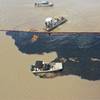ABS Notation for Well Test Ops Vessels, MODUs
ABS has issued a series of notations in support of critical well testing activities being undertaken by energy operators worldwide to determine the commercial nature of their reservoirs.
The importance of well testing to determine the nature of reservoirs has become even more critical lately as ultra deepwater exploration with pre-salt fields now has operators exploring in water depths surpassing 10,000 feet. Not only is the depth a challenge but also the complexity of the reservoir structures.
A vessel or mobile offshore drilling unit (MODU) with the equipment and capabilities to engage in well testing, either short-term or extended, is key in gathering onsite data to determine the size and quantity of the hydrocarbon potential.
Testing on board these units is usually performed to determine the size, viability and optimum production capabilities of a field under exploration. With a processing plant on board, a well test vessel can salvage the products from the well by separating the oil, water and gas and processing the oil to refinery standards.
“Well test vessels, especially those on station for an extended period of time, are relatively sophisticated vessels so this notation now provides a testament to their capability,” said Kenneth Richardson, ABS Vice President, Energy Development. “In terms of systems you have to consider well control equipment, process pressure vessels, piping and electrical components, control systems, burners and gas flares and burners and flare booms,” he added.
The ABS Guide for Well Test Systems takes into account the different scenarios during the life of the vessel or unit with flexibility to cover the surface systems and equipment safety aspects. Guidance is provided for both permanent well test systems (well test systems installed on board for at least 30 months are considered permanent, Well Test Service) and temporary well test systems (well test systems installed on board for less than 30 months, WT-TEMP). The Guide also offers a notation to those vessels or units designed to perform well test activities but the well test systems have not yet been installed on board, WT-Ready.
Outfitting vessels or units for well testing means close attention to issues such as the deck structure so that the deck is appropriately reinforced to support the well test systems. This includes the crude storage tank structure permanently installed on board and designated for crude storage during well testing operations in compliance with applicable class structural requirements, hazardous areas for electrical equipment created by the presence of hydrocarbons and spill containment provided in areas which may be subject to hydrocarbon liquid or chemical spills when the well test system is installed.










